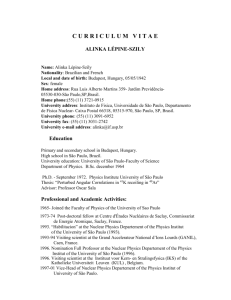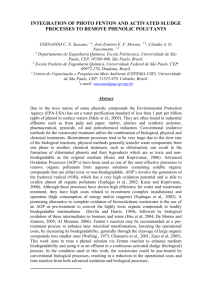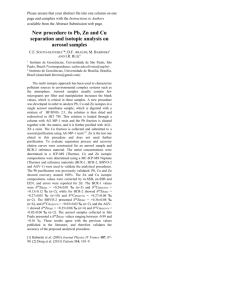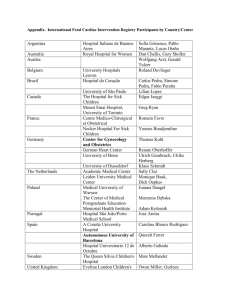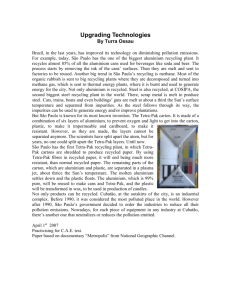The economic valyue of free time
advertisement
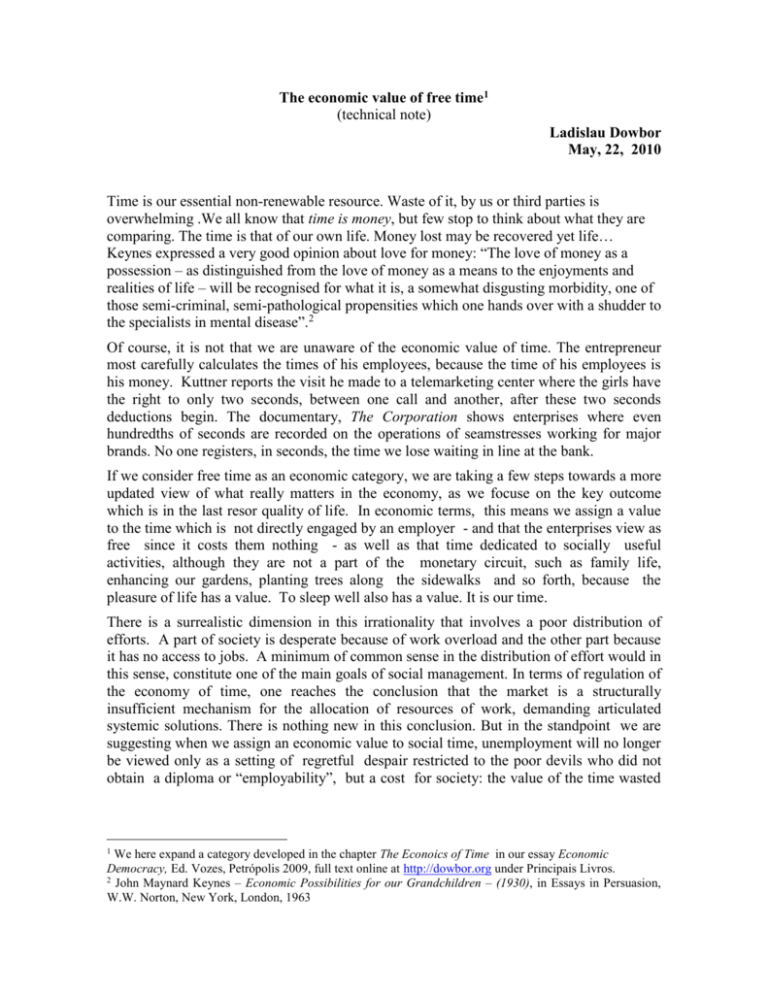
The economic value of free time1 (technical note) Ladislau Dowbor May, 22, 2010 Time is our essential non-renewable resource. Waste of it, by us or third parties is overwhelming .We all know that time is money, but few stop to think about what they are comparing. The time is that of our own life. Money lost may be recovered yet life… Keynes expressed a very good opinion about love for money: “The love of money as a possession – as distinguished from the love of money as a means to the enjoyments and realities of life – will be recognised for what it is, a somewhat disgusting morbidity, one of those semi-criminal, semi-pathological propensities which one hands over with a shudder to the specialists in mental disease”.2 Of course, it is not that we are unaware of the economic value of time. The entrepreneur most carefully calculates the times of his employees, because the time of his employees is his money. Kuttner reports the visit he made to a telemarketing center where the girls have the right to only two seconds, between one call and another, after these two seconds deductions begin. The documentary, The Corporation shows enterprises where even hundredths of seconds are recorded on the operations of seamstresses working for major brands. No one registers, in seconds, the time we lose waiting in line at the bank. If we consider free time as an economic category, we are taking a few steps towards a more updated view of what really matters in the economy, as we focuse on the key outcome which is in the last resor quality of life. In economic terms, this means we assign a value to the time which is not directly engaged by an employer - and that the enterprises view as free since it costs them nothing - as well as that time dedicated to socially useful activities, although they are not a part of the monetary circuit, such as family life, enhancing our gardens, planting trees along the sidewalks and so forth, because the pleasure of life has a value. To sleep well also has a value. It is our time. There is a surrealistic dimension in this irrationality that involves a poor distribution of efforts. A part of society is desperate because of work overload and the other part because it has no access to jobs. A minimum of common sense in the distribution of effort would in this sense, constitute one of the main goals of social management. In terms of regulation of the economy of time, one reaches the conclusion that the market is a structurally insufficient mechanism for the allocation of resources of work, demanding articulated systemic solutions. There is nothing new in this conclusion. But in the standpoint we are suggesting when we assign an economic value to social time, unemployment will no longer be viewed only as a setting of regretful despair restricted to the poor devils who did not obtain a diploma or “employability”, but a cost for society: the value of the time wasted 1 We here expand a category developed in the chapter The Econoics of Time in our essay Economic Democracy, Ed. Vozes, Petrópolis 2009, full text online at http://dowbor.org under Principais Livros. 2 John Maynard Keynes – Economic Possibilities for our Grandchildren – (1930), in Essays in Persuasion, W.W. Norton, New York, London, 1963 2 may be much higher than the cost of organizational measures that assure work useful for all.3 To assess the economic value of our free time may have major impacts on how we organize economic decisions and about investment priorities, in addition to solving the problem of including in the GDP some non-monetary categories. The most practical way to explain the methodology is to apply it to a concrete case, that of the city of São Paulo. The example of São Paulo São Paulo has 11 million inhabitants. The city’s GDP is 320 billion reais. Dividing the GDP by the population we have a yearly per capita GDP of 29 thousand reais. This is clearly a very high amount. But what is of interest for us here is that based upon this figure we can calculate the value of the hour per capita. Dividing 29 thousand reais by 8,760 hours, which is the number of hours in a year, we reach the value of 3.30 reais. This would be the mean value of the São Paulo citizen’s hour, in general terms4 To define a basic value for the time of the “paulistano” allows us to reach a much more realistic outlook of the economic accounts. Essentially it is a practical way of allocating an equivalent money-value to a set of activities we do not account for, simply because they do not cost money nor do they bring about a register of monetary exchanges. What follows is a possible application of the methodology to the city. Here, the issue is not to replace the concept of the Gross Domestic Product, but to give economic visibility to a set of activities not accounted for, since they are time consuming activities. If we use a general money equivalent to our time, we can have a more realistic GDP, not to speak of other possibilities.5 Cost of time in traffic It is widely known that time lost in traffic is a waste. From the point of view of the GDP , the fact that so many are obliged to buy a car and use it permanently – due to the precariousness of public transport services - appears to be a positive contribution. The production of cars, fuel consumption, infrastructure investments, accidents and hospital bills all improve GDP. Starting in 2003, the World Bank began to discount in the calculation of the contribution of car production to the GDP, costs generated with healthcare. In our case, in a broader approach we shall consider that the six million people in the economically active population of the city are penalized by losing time in transport means where they do not rest, produce or invest (except those very few who for instance profit from traffic jams to study languages and similar activities). One hour lost by six The classic on the subject is the book by Guy Aznar “ Travaillons moins pour travailler tous” - preface by André Gorz. Keynes already stresed “the enormous anomaly of unemployment in a world of needs”. 4 Data from Seade Foundation , www.seade.gov.br/produtos/perfil/perfil.php, Perfil Municipal,(Municipal Profile) São Paulo. 5 The GDP itself is being reevaluated in the most varied jurisdictions. About the shortcomings of the GDP see our “Debate about the GDP: We are making the wrong account calculation”. http://dowbor.org/09_pibestamosfazendoacontaerrada.doc 3 2 3 million active persons means six million hours lost. If we calculate the value of the lost hour at 3.30 reais, these add up to 19, 8 million reais lost per hour. According to surveys of the movement “Nossa São Paulo”, the average active citizen of São Paulo wastes two hours and forty minutes in traffic each day. This means a time-cost of 52.8 million reais per day, representing the extent of the losses caused to the city by the inefficiency of transport options. Another way of approaching this calculation relates to investment policies. If Sao Paulo loses, in round numbers, 20 million reais per hour of time lost in traffic, this means if investments in the subway and bus corridors would save half an hour per day of our time, this would add up to 10 million reais gained per day. Since a kilometer of subway costs 200 million reais, in approximate values, this means that in the calculation of return on investments we should take into account not only how much people will pay for the tickets, but also the diffuse savings for society as a whole. With 10 million saved per day, this alone already pays for a kilometer of subway every 20 days. Not to include this calculation in the evaluation of investments is to make a wrong calculation. From a micro-economic standpoint it is even correct since those who invest believe that what interests them is only the money from the tickets: savings made by the population as a whole do not fill their pockets. But, from the standpoint of the systemic productivity of the territory, the overall rationality increases, because as people waste less time and money in transportation, the situation of all is improved. Incomplete accounting is wrong accounting. The cost of unemployment Another form of making good use of the money equivalent of time is to assess unemployment. São Paulo, has an active population of about six million people, with an open unemployment of 7% (IBGE criterion) and an unemployment that includes unemployment by discouragement of some 14% (DIEESE criterion).This second criterion is unquestionably more realistic for an economy such as that of Brazil. Fourteen percent of six million are 840 thousand unemployed. Regardless of the human costs that this entails we can assess, in lost working hours, what this represents as a loss for the city. If we calculate the daily losses as being 8 hours of potential work not performed we have a daily loss of 6.72 million hours. This multiplied by R$3.30 represents R$22.2 million wasted per day. From a propositional standpoint, when an initiative of creating urban maintenance services is taken - basic sanitation, tree planting, support for self-construction and repair of dwellings etc - paid with a minimum wage, the cost of 22 million per day is transformed into investment in the quality of urban life. Celso Furtado used to say that when the production of a person is zero, any activity is a profit. Indeed, to become aware that each hour of lost activity represents a cost facilitates the understanding and acceptance of policies for job security. As such, to assign a value equivalent to the hour of the São Paulo citizen allows us to better assess how we are spending our money. Organization of the process of employment guarantee today is no mystery whatsoever, a policy implemented in India in the State of Maharashtra for 10 years with good results is now being extended to the entire country. 3 4 Not everybody would be willing to work for a minimum wage. But many unemployed with a better education - and they are many - might be engaged in education and healthcare, that today cause protests because it would be “inflating the public machine”. The truth is that the unemployment is a cost and to become aware that they cost us more than 20 million reais a day could make the city more dynamic in terms of promoting jobs. The contribution of volunteers Another way of taking advantage of the equivalence value of time is to evaluate the work rendered by volunteers. For many, this is not an important activity, “marginal” from an economic standpoint. In this sense, the example of the “Pastoral da Criança” is quite meaningful. The “Pastoral” has 350 thousand volunteers and in the regions where it acts, has brought about a 50% decrease in infant mortality and 80% reduction in hospital admissions. In terms of traditional accounting this is not a positive activity: to the contrary, when reducing medicine consumption, use of ambulances and days of hospital stay , the GDP is reduced and since the activity is not remunerated it is not included in the GDP as a positive contribution. If we estimate that the “Pastoral” volunteers dedicate to the children one hour of work a day, at R$3.30 an hour, we can assess the “Pastoral’s” contribution as R$1,155,000 per day. We have no estimates about the number of hours of volunteer work in the city of São Paulo. But, certainly it is very significant and assessment by means of the equivalent value in hours would allow us to reach a more realistic approximation of the values of activities in the city. This calculation will bring about a better balance of the political decisions in the city, especially since volunteering is expanding in the country due to the proliferation of civil society organizations that make intense use of volunteers. The contribution of household chores Another important potential of the value equivalence value of time is the always difficult assessment of non remunerated chores in households. In the classic example, the person who planted, harvested and sold the head of lettuce carried out an economic activity, while the person who went to buy it at the market, carried, washed, prepared and served this same lettuce does not contribute to the economy. Furthermore, the person who bought, washed and prepared and served this same lettuce in a restaurant does indeed contribute to the economy. The difficulty to assess such an activity is well acknowledged. However to assess the time of domestic chores in the households today is a rather simple and familiar task for statisticians who for instance carry out the “National Survey by Household Sampling”. It is not difficult to make a survey by sampling how much time women spend on their second shift. “The Synthesis of Social Indicators 1996-2006” by the IBGE , mentions that “regarding the average number of working hours spent weekly on household chores, it is perceived that women work more than twice as much as men in these activities (24.8 hours).” 6 If See data in the “Synthesis of Social Indicators 1996-2006” by IBGE, graph 4.1 and following pages doc. s.p. – The complete document “ Synthesis of Social Indicators 2007 – An analysis of life conditions of the Brazilian population 2007 – is available in 6 4 5 we estimate – while the corresponding sampling for the city of São Paulo in not yet available - that the Brazilian average is valid for São Paulo, we can calculate the value of this contribution. The calculation is simple: of the 11 million people in the city we subtract 2.7 million who are less than 15 years old and 1.3 million with more than 60 years of age, 7 million working age adults remain. Half of this population represents 3.5 million women (it would be a little more than half due to the larger female population, however this does not significantly change the calculation) who spend 24.8 hours weekly, three and a half hours daily, on household chores. With the value of R$3.30 per hour, 3.5 million people with work of 3.5 hours per day, add up to R$40.4 million reais per day. Since in the family one eats and washes dishes even on Sundays, multiplying R$ 40.4 by 365 days, the women in the city of São Paulo contributed R$14.7 billion to the economy of the city, to be added to the R$320 billion of the GDP as calculated by SEADE. Perspectives of the value equivalent of our time To utilize the value equivalent of an hour of our time may have other uses. For instance, we lose time queuing at the bank. From the bank’s standpoint, the hour of the employee is paid whereas the hour of the customer is free. Therefore, it is better to have less employees and longer queues. In economics this is called externalization of costs. Of course there are limits and sometimes expressions of indignation by the clients. However, if other banks adopt the same policies, the majority sighs in the queue or hires youngsters whose occupation will be to wait in line. This is not complicated to calculate, by branch, multiplying the people by the average waiting time, we obtain the value lost by all, a time during which one does not rest nor work. And the youngster waits in line instead of studying or having fun. A similar vector of costs may be calculated based upon the average waiting time for the bus. From the standpoint of the bus company, the best thing is to have a very full bus which makes the trip profitable. As such, it is better to delay a little, so that the number of passengers at the bus stops increases. The average time lost waiting for public transport can be rather easily calculated and multiplied by the value equivalent of an hour of the São Paulo citizen. When calculating the availability of public transport the correct accounting therefore requires that the complete social costs are taken into account. Once again, the cost for the citizen in terms of time lost does not come out of the company’s pocket and the time eventually saved will not fill it. The obvious implication is that the companies’ micro-economic calculation is not sufficient, the assessment of systemic productivity for the city as a whole must be calculated. The overall losses for the population do have economic value. It would be most useful to assess, according to the criterion of value of time, the productivity of public or private systems that involve bureaucracy in general. For certain taxes, the cost/benefit of different taxes is calculated. Some generate more work for the public administration than the resources generated. However, costs for the citizen in terms of time lost must also be included. If we multiply the number of tax payers and the time to http://www.ibge.gov.br/home/estatistica/populacao/condicaodevida/indicadoresminimos/sinteseindicsociais20 07/indic_sociais2007.pdf About the trends in family breakup, see our article Economia da Familia under Artigos Online in our site www.dowbor.org 5 6 fill out forms or wait in line by the equivalent basic value of the citizen’s hour we will reach a more correct calculation of the social cost of the tax collection. Certain bureaucratic documents or procedures require hours of waiting. This is a cost. If we apply the accounting of hours lost, we will be able to better certify the productivity of acquiring a more advanced equipment to reduce queues or simplify taxes. Obviously, the examples can be multiplied. How much is the time waiting for health services worth? What is the value of the time lost by the citizen, but not by the company when dialing dozens of times a number answered by a mysterious voice informing us that “your call is very important for us”. Important for the mysterious “us” but of course, a direct cost for the user’s pocket. How much does the service cost that we are requesting and that will be performed “during business hours”, obliging us to stay at home waiting? The supplier’s time cannot be wasted, but ours can. Telemarketing evaluates its costs in terms of the employees and telephone rates. What about the time lost by millions of potential clients? Only a minimal proportion of calls results in sales and that is why there must be millions of calls. A few minutes of millions of people represent a most significant cost of wasted time – not to mention the irritation. Other forms of advertising, in particular “spam” represent, worldwide hundreds of millions of hours lost erasing stupidities and being distracted from what we are doing, with an overall loss of productivity. The cost of healthcare will be more complete if we include the work days lost with diseases. To take into account this cost of this time would render the productivity of investing in preventive healthcare much more evident. Special attention should be given to the calculations we make about shortening the working day. In the calculations of the opponents, who consider that the hour away from economically remunerated work has no value, to warrant the forty weekly hours and therefore two full days of rest to the workers would entail a drop in production. Naturally, because they do not consider the time spent with the family as having a value, the well deserved rest, the leisure. In reality, they are making the wrong calculation, even on the strictly micro-economic level since, where shortening of the work days was introduced, other economic activities more related to leisure and culture, sports and the like expanded. But in the methodology we are addressing here, to increase leisure does not reduce production, since we begin to calculate the value of free time also as a value for the population. A methodology is being defined We here elected the simplest one: the value of the GDP divided by the population, which gives us the yearly per capita GDP. By dividing this by the hours of the year, we obtain the per capita value of the hour. But we can think about different calculations. Steven Davis in the United States started from the mean value of the hourly wages once taxes were deducted and assigned this value to the hour of leisure, something like 13.2 dollars. A gain of five hours of leisure per week would amount to 3,300 dollars per worker and per year.7 The important thing, in methodological terms is that the figure be clearly The Economist, February 4th 2006, pg. 29; the methological issue is also raised in the Stiglitz-Sen-Fitoussi report to be found under http://www.stiglitz-sen7 fitoussi.fr/documents/draft_summary.pdf , 2009 6 7 understandable for non-experts. The yearly per capita is an understandable figure and assimilated by the majority of the population. The per hour per capita is likewise transparent. We could as a divisor utilize only the active population instead of the total population, or the mean working hours instead of the total hours per year – which would cause problems since we are assessing the total hours, including more precisely, free time. This would not change the overall meaning of the assessment and would only make the understanding more difficult. On the other hand, the methodology stresses the importance of regularly conducting surveys about the use of time in the society. On the international level, there are studies of the time budget that have not yet been introduced in Brazil. The issue is our most precious asset, the time of our very own life. To understand how we use it and the cost of its waste is essential to start organizing our activities regarding the quality of life and to update our accounts. Ladislau Dowbor, is a Ph.D. in Economic Sciences from the Central School of Planning and Statistics in Warsaw; a tenured professor at PUC, São Paulo, and consultant for various agencies of the United Nations. He is the author of, “Economic Democracy”, “Social Reproduction: proposals for a decentralized management”. His numerous works about economic and social planning are available in the site http://dowbor.org – Contact ladislau@dowbor.org 7


